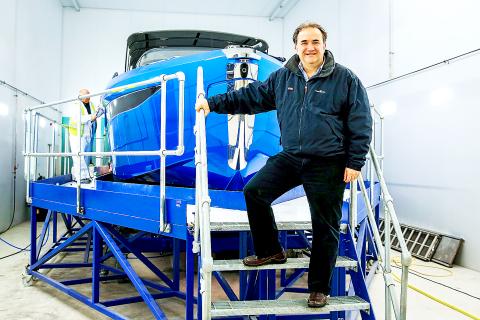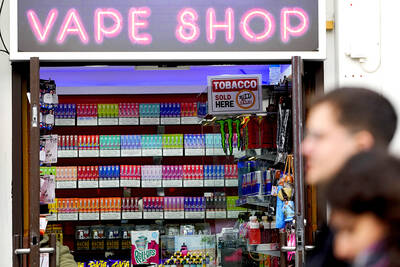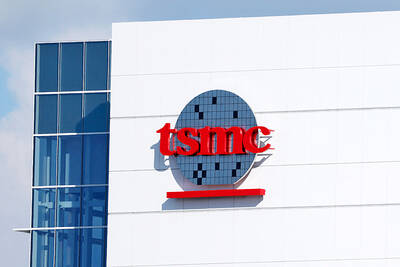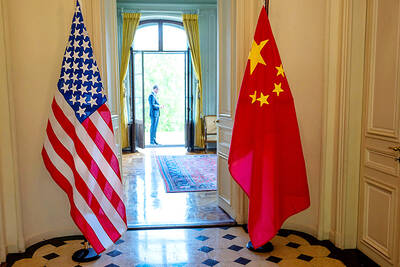Antony Sheriff came to Princess Yachts International PLC three years ago, not long after leaving McLaren Automotive. He expected to bring lessons learned from making supercars to yacht manufacturing, a hidebound business famous for losing money the old-fashioned way — hand over first when times got tough.
With no experience in boatbuilding, executive chairman Sheriff suspected that many of the auto industry’s cost-cutting strategies developed over the past two decades would transfer neatly.
However, he soon found how little the application of time-honored money savers, like outsourcing and cutting jobs, transferred to hand-building yachts and superyachts of up to 40m in Plymouth, on England’s south coast.

Photo: Bloomberg
So rather than streamlining Princess Yachts, Sheriff took a different tack: Go upmarket, innovate, improve design.
In just a few years, he has expanded staff by about 1,000, or almost 50 percent. Some new looks, such as the R35, come from Italy’s storied house of Pininfarina, the hand behind scores of Ferraris, Alfa Romeos and Lancias. Beneath that design, the yacht also features a stability mechanism first developed for British efforts to capture the America’s Cup.
The timing of the turnaround could not be better. The current economic climate, with a growing class of super-rich, has been good for the yacht trade, and Princess, which last year earned almost £30 million (US$36 million) on revenue of about £340 million, has been among the lucky beneficiaries. Its books are filled through the year and well into next year, with more than £700 million in commissions. To match record boat sales, record-high employment of 3,200 makes Princess one of the UK’s largest specialist manufacturers, overtaking Aston Martin.
Princess was sinking financially as recently as 2015, with a £19 million loss. L Capital 2 FCPR — a private investment fund underwritten by LVMH, the owner of luxury brands like Louis Vuitton and Dom Perignon — had acquired the company 11 years ago from its founder, David King.
The new owners, along with the family investment house of billionaire chairman Bernard Arnault, brought fiscal muscle and a necessary modicum of patience to the task of righting the respected builder of sturdy, but slightly dull, luxury craft. A £100 million, five-year turnaround plan started in 2016 and coincided broadly with the announcement of a partnership between LVMH and Catterton, the wealthy Greenwich, Connecticut-based private-equity firm, an association known as L Catterton. It controls the yacht maker today. Sheriff joined not long after the deal was done.
“When I got here I thought: ‘We’ve got an amazing facility with people with 50 years of experience working in it. We make everything ourselves. We’re vertically integrated to a ridiculous extent,’” he said in an interview. “And then I looked around and realized: ‘Well, there’s nobody else within 200 miles [322km] who can make this stuff anyway.’”
So with outsourcing off the table, hand-crafted work became a marketing line. “Our brand is no longer ‘Princess.’ It’s ‘Princess, crafted in Plymouth,’” he said.
About 75 percent or more of each Princess yacht is made on site — all the way down to wire harnesses and fuel tanks.
“We really do have little old ladies and little old men and young men and young women making everything,” Sheriff said. “The customers come and they see not just a boat being assembled with purchased parts, but they see sheets of wood coming in and being transformed into this beautiful furniture.”
Sheriff, a 56-year-old with American and Italian roots, grew up in New England, but has lived much of his adult life in England. He started at Chrysler before moving to Fiat, then jumped to a top role at McLaren in 2003. He is credited with the successful launch of the F1 constructor’s first 21st-century road car, the MP4-12C, and its £1.3 million P1 gasoline-electric hypercar.
However, he clashed with then-company chairman Ron Dennis, as, it is fair to say, did many others whose path crossed that of the successful race team owner.
Sheriff’s ties to the automobile industry remain strong. He sits on the board at three promising new-tech automotive ventures: Rivian, a Michigan-based start-up that plans to build electric pickup trucks and SUVs; Rimac, a dynamic and highly regarded Croatian outfit whose advanced electric vehicle technology and engineering nous have already attracted significant investment from Porsche and other heavyweights; and Pininfarina.
Reinvigorated with the backing of new owner, India’s Mahindra and Mahindra, it is building a 1,900-horsepower, all-electric, all-wheel-drive hypercar: the US$2.1 million Pininfarina Battista.
Sheriff still talks like a car guy — for instance, when describing Princess’ just-launched R35 “sports yacht.”
“It’s our nautical equivalent of a supercar,” Sheriff said of the swoopy, 10.89m V8-powered yacht, which looks like a large-but-sleek racing boat, with a swishy cabin that will travel at a brisk 50 knots (93kph) until the fuel runs out.
One strategy Princess took from the car industry is “platform sharing,” the idea that the parts hidden from view — the undercarriage and mechanical systems, for example — can be shared across a variety of models, while the exterior surfaces change, reducing cost and complexity.
“You’ll see a hull which has the same hull molding, but a completely different concept for the boat above.” Sheriff said. “So what sits above the deck is differently laid out, with different shapes. What sits below deck is identical.”
That means tweaks to exterior design and treatments create the appearances of new yachts, when in fact they are born from the same mold.
The overall approach has captivated the industry press, said David Robinson, a longtime UK yachting business journalist. “This company has been totally rebuilt using investment as a catalyst to boost product development, upgrade manufacturing facilities, increase its marketing and enhance its international distribution network.”
“The outcome of these efforts shows through,” Robinson said.
Beyond the sheer number of millionaires and billionaires, Sheriff sees two more industry tailwinds.
The big one: Just like supercars, improved technology means pretty much anyone can skipper a yacht.
“If you know how to drive a Fiesta, you can drive a McLaren,” he said. “Boats are the same. They’ve become a lot less intimidating... You want it to stay where it is? You just hit a button. It locks into the GPS — no matter what the current is, it stays where it is.”
The other trend is a push for solitude.
“People buy them because they love spending time in a quiet place with their family, away from everything else, where the kids can’t run off,” he said.
“They’re in tune with this conception of how you want to spend holiday time if you have money: Rather than private jets and stuff, you go out on a boat and spend high-quality time,” he said.

Real estate agent and property developer JSL Construction & Development Co (愛山林) led the average compensation rankings among companies listed on the Taiwan Stock Exchange (TWSE) last year, while contract chipmaker Taiwan Semiconductor Manufacturing Co (TSMC, 台積電) finished 14th. JSL Construction paid its employees total average compensation of NT$4.78 million (US$159,701), down 13.5 percent from a year earlier, but still ahead of the most profitable listed tech giants, including TSMC, TWSE data showed. Last year, the average compensation (which includes salary, overtime, bonuses and allowances) paid by TSMC rose 21.6 percent to reach about NT$3.33 million, lifting its ranking by 10 notches

Popular vape brands such as Geek Bar might get more expensive in the US — if you can find them at all. Shipments of vapes from China to the US ground to a near halt last month from a year ago, official data showed, hit by US President Donald Trump’s tariffs and a crackdown on unauthorized e-cigarettes in the world’s biggest market for smoking alternatives. That includes Geek Bar, a brand of flavored vapes that is not authorized to sell in the US, but which had been widely available due to porous import controls. One retailer, who asked not to be named, because

SEASONAL WEAKNESS: The combined revenue of the top 10 foundries fell 5.4%, but rush orders and China’s subsidies partially offset slowing demand Taiwan Semiconductor Manufacturing Co (TSMC, 台積電) further solidified its dominance in the global wafer foundry business in the first quarter of this year, remaining far ahead of its closest rival, Samsung Electronics Co, TrendForce Corp (集邦科技) said yesterday. TSMC posted US$25.52 billion in sales in the January-to-March period, down 5 percent from the previous quarter, but its market share rose from 67.1 percent the previous quarter to 67.6 percent, TrendForce said in a report. While smartphone-related wafer shipments declined in the first quarter due to seasonal factors, solid demand for artificial intelligence (AI) and high-performance computing (HPC) devices and urgent TV-related orders

MINERAL DIPLOMACY: The Chinese commerce ministry said it approved applications for the export of rare earths in a move that could help ease US-China trade tensions Chinese Vice Premier He Lifeng (何立峰) is today to meet a US delegation for talks in the UK, Beijing announced on Saturday amid a fragile truce in the trade dispute between the two powers. He is to visit the UK from yesterday to Friday at the invitation of the British government, the Chinese Ministry of Foreign Affairs said in a statement. He and US representatives are to cochair the first meeting of the US-China economic and trade consultation mechanism, it said. US President Donald Trump on Friday announced that a new round of trade talks with China would start in London beginning today,